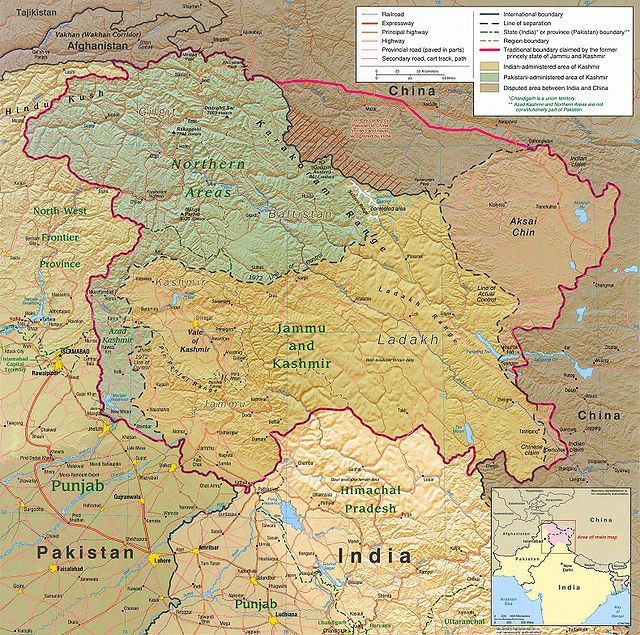I have blogged about Pakistan and India before in the context of their hostilities and the danger that they might engage in an exchange of nuclear warheads. They have around a hundred warheads each. It has been estimated that the detonation of only one hundred warheads might be sufficient to trigger a nuclear winter that would end human civilization. They have gone to war three times since India and Pakistan were created in 1949.
Both India and Pakistan claim the Kashmir region. The name Kashmir used to designate only the valley between the Himalaya and the Pir Panjai mountain ranges. Now the term "Kashmir" refers to a much bigger area. It includes the Indian state of Jammu and Kashmir, the Pakistani territories of Azad Chin and Gilgit-Baltistan and the Chinese controlled Aksai Kashmir and the Trans-Karakoram Tract. Most of the border between the Pakistani and Indian controlled parts of Kashmir is marked by a double twelve foot fence with barbed wire on the top. Much of the rest contains thousands of land mines. There is often automatic weapons fire and mortar fire between the two nations across the border also called "Line of Control" which is really only the cease fire line drawn following hostilities in 1972. This openly contested region could be the trigger for a new war between Pakistan and India.
Pakistan is dependent on the Indus river for ninety percent of its irrigation water and fifty percent of its employment. The Indus river runs through India before it reaches Pakistan. An agreement over water rights and usage was reached some time ago. Since then, the populations of both countries have exploded and water resources have become more scarce. Now India is building forty five new hydroelectric dams on the Indus in India to supply desperately needed power to India. Pakistan is claiming that India is stealing their water and breaking the agreement. Most nuclear nations have made it official policy to not be the first to launch nuclear missiles in a dispute with another nation. Pakistan has stated that it reserves the right to launch a first nuclear strike against India if India seriously interferes with the flow of water in the Indus River before it reaches Pakistan.
Pakistan is a very unstable country. Eight different Islamist militant groups including Al-Qaeda and the Taliban have just joined together in a united jihad coalition against India. There is great international concern that the current government of Pakistan might be overthrown and replaced with a fanatic Islamist government that would have nuclear warheads. India has just elected a new nationalist government which is taking a hard line against Pakistan. Tensions are on the rise between the two nations. The presence of religious fanaticism in the hostilities between India and Pakistan make the idea of mutually assured destruction preventing nuclear war much less likely.
As always, when examined closely, issues of nuclear weapons and nuclear power intertwine with economic, social and resource issues. India must increase both energy production and availability of clean water in the near future or face social chaos. Part of India's plan includes building new nuclear reactors, developing a commercial thorium reactor and desalinating water from the ocean (which requires a great deal of energy.) India has sufficient sunshine to power solar energy arrays that could provide the needed electricity the nation and also provide as much water as India requires through desalinization. Hopefully India will be able to meet its energy, water and security needs without the need for nuclear power or nuclear weapons.
